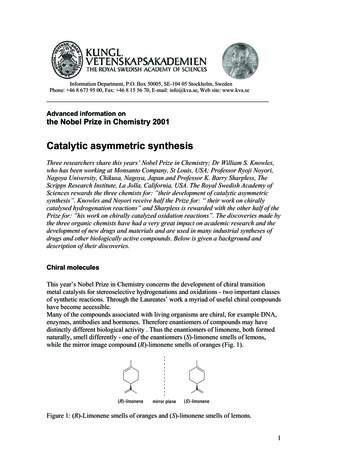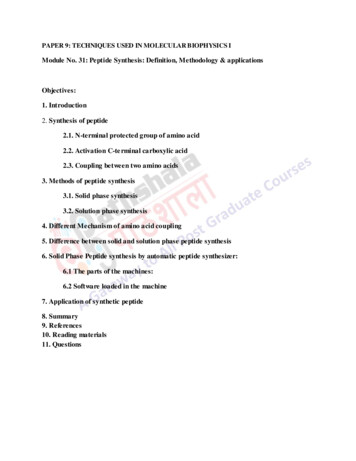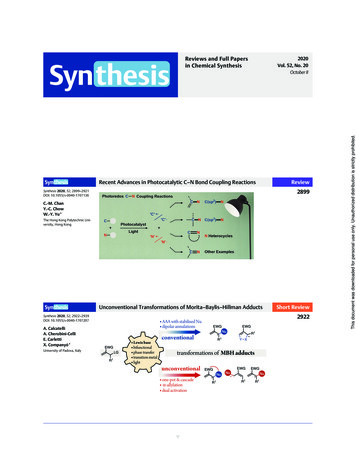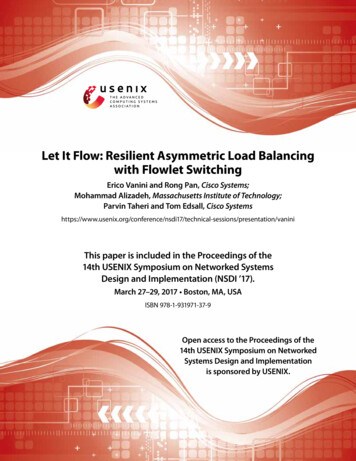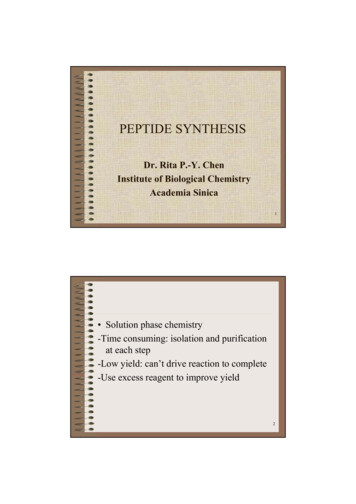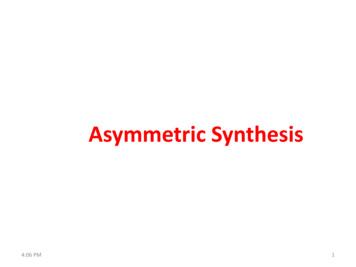
Transcription
Asymmetric Synthesis4:06 PM1
Asymmetric SynthesisWhat is Asymmetric Synthesis?Asymmetric synthesis relates to any synthetic process thatintroduces one or more new elements of chirality during afunctional group transformation.4:06 PM2
Asymmetric SynthesisWhat is Asymmetric Synthesis?In asymmetric synthesis, the reactions are either highlyenantioselective (high ee) or enantiospecific (100% ee).Prior to the development of efficient methods of asymmetricsynthesis, resolution was used to access enantiopuremolecules.But, resolution is not very efficient as the maximum yield of thedesired enantiomer is only 50%.4:06 PM3
Asymmetric SynthesisWhy is Asymmetric Synthesis Important?The ability to synthesize single enantiomers of chiral moleculesis important since biological systems, where they are intendedfor application, are also chiral.Different enantiomers often interact with the target biologicalreceptors very differently and often with different responses.Example4:06 PM4
Asymmetric SynthesisThe Way Forward in Asymmetric SynthesisTo access enantiomerically pure molecules for biologicalapplications as drugs, sweeteners and moisturizers, there isneed for adoption of efficient strategies for asymmetricsynthesis.Strategies of Asymmetric SynthesisWe will cover the two main strategies of asymmetric synthesis: Chiral pool synthesis or chiron approach Chiral auxiliary approach4:06 PM5
Chiral PoolChiral pool refers to a collection of enantiomerically puremolecules available from nature.Common chiral starting materials derived from nature includeamino acids, chiral carboxylic acids and monosaccharides.4:06 PM6
Chiron Approach to AsymmetricSynthesisA chiron approach or chiral pool synthesis refers to a syntheticprocess that employs a member of the chiral pool as a startingmaterial (SM) in the synthesis of a target molecule (TM).The chiral centre(s) in the starting material are (but not all arealways) preserved in the target molecule (TM).It may use pre-existing chiral centres from the chiral poolsubstrate to influence formation of new chiral centres.The new chiral centres can be generated through substitutionor addition reactions.4:06 PM7
Chiral Pool SynthesisFunctional Group InterconversionChiral pool synthesis of L-glyceraldehyde, the unnatural sugar,from the natural amino acid L-Serine.4:06 PM8
Chiral Pool SynthesisFunctional Group InterconversionChiral pool synthesis of the essential amino acid, L-lysine fromthe natural non-essential amino acid L-serine can also beachieved.4:06 PM9
Asymmetric SynthesisVia Substitution Reactions (Revisited)SN1 vs SN2: Which is best for asymmetric ySN1First OrderStepwise ReactionNon StereospecificRacemization occursSN2Second OrderConcerted ReactionStereospecificComplete inversionBest Substrates3o and 2o Substrates1o and 2o SubstratesNucleophileGood nucleophile works Strong nucleophile bestLeaving GroupGood leaving groupGood leaving groupFor being stereospecific, SN2 reactions on 2o substrates are4:06 PM10more reliable in asymmetric synthesis.
Asymmetric SynthesisSN2 Reactions: Strong Nucleophile NeededA nucleophile is an electron rich species that has a negativecharge or at least a lone pair of electrons.There are generally three factors that determine the trend innucleophilicity of a reactant:1) Size- Generally, the more linear or smaller the nucleophile,the more nucleophilic it will be. It avoids steric hinderance ifit is smaller or linear.2) Electronegativity- The more electronegative an atom is, theless nucleophilic it will be. Nucleophilicity decreases acrossthe periodic table (C N O F)3) Polarizability- The more polarizable an atom is, the morenucleophilic it will be. Generally, polarizability increases4:06 PM11down the periodic table (I Br Cl F)
Asymmetric SynthesisSN2 Reactions: Strong Nucleophiles NeededCategories of NucleophilesVery Good nucleophilesGood nucleophilesFair nucleophilesWeak nucleophilesVery weak nucleophilesHS-, I-, RSBr-, HO-, RO-, CN-, N3NH3, Cl-, F-, RCO2H2O, ROHRCO2HThe best nucleophiles should also be weak bases to limit thecompetition between substitution and elimination.4:06 PM12
Asymmetric SynthesisSynthetically Important NucleophilesNucleophile Source4:06 PMSynthetic Targets-SHNaSHThiols such as cysteineRS-RSNaThioglycosidesI-NaIAlkyl iodidesBr-NaBrAlkyl bromides-CNNaCNCyanohydrins and 1o amines-N3NaN3Chiral amines and amino acids13
Asymmetric SynthesisSN2 Reactions: Good Leaving Groups NeededA leaving group is an atom (or a group of atoms) that is displaced as stablespecies taking with it the bonding electrons.The leaving group may be an anion (e.g. I-) or a neutral molecule (e.g. H2O).The better the leaving group, the more likely it is to depart: The more thestable a Lvg- is, the more it favours its "leaving".A good leaving group is the conjugate base of a strong acid.Some of the strongest organic acids are the sulphonic acids.4:06 PM14
Asymmetric SynthesisSN2 Reactions: The Good Leaving GroupsClassification of Leaving GroupsExcellent leaving groupsVery Good leaving groupsTsO-, MsOI-, H2OGood leaving groupsBr-Fair leaving groupsCl-Poor leaving groupsF-Very poor leaving groupsHO-, NH2-, RO-Generally, the order of leaving group ability is as follows:TsO- (Excellent) I- Br- Cl- F- (Poor)4:06 PM15
Chiral Pool SynthesisNew Chiral Centres through Substitution ReactionsChiral pool substrates that are commonly used in organicsynthesis contain functional groups that are poor leaving groups.These functional groups have to be converted into good leavinggroups that can be used in substitution reactions.4:06 PM16
Chiral Pool Asymmetric SynthesisSynthesis of Unnatural Amino AcidsThe chiral pool synthesis of D-alanine from L-lactic acid can beachieved via conversion to p-toluenesulphonate.Any synthetic success dictates for a judicious introduction ofprotecting groups in the starting material to assist subsequent4:06 PM functionalization to the target molecule.17
Chiral Pool Asymmetric SynthesisSynthesis of Unnatural Amino AcidsChiral pool synthesis of the unnatural amino acid, D-cysteine,from the natural L-serine is feasible.4:06 PM18
Chiral Pool Asymmetric SynthesisSynthesis of Natural Amino AcidsThe chiral pool synthesis of L-alanine from L-lactic acid can beachieved via double inversion through an iodide.Note that the iodination with PPh3/I2 follows an SN2 pathwayleading to inversion of configuration during the formation of the4:06 PM iodide from benzyl lactate.19
Chiral Auxiliary Approach to AsymmetricSynthesisWhat is a Chiral Auxiliary?A chiral auxiliary is a chiral molecular unit that can betemporarily incorporated in an achiral substrate to guideselective formation of one of a possible pair of enantiomers.Chiral auxiliaries are optically active compounds and introducechirality in otherwise achiral starting materials.Examples of chiral auxiliaries used in the alkylation of enolates.4:06 PM20
Chiral Auxiliary Approach to AsymmetricSynthesisHow Does a Chiral Auxiliary Work?A chiral auxiliary physically blocks one of two possibletrajectories of attack on an achiral substrate, leaving only thedesired trajectory open for reaction.Since the chiral auxiliary is enantiopure, the two trajectories arenot equivalent but diastereomeric.The temporary stereocenter introduced by the chiral auxilliarydirects the formation of a second stereocenter.The stereochemistry of the new chiral centre can berationalized based on steric considerations.4:06 PM21
Chiral Auxiliary Approach:Asymmetric Enolate AlkylationOptically active carboxylic acids can be prepared with highenantiomeric excess based on the chiral auxiliary approach toasymmetric synthesis.4:06 PM22
Chiral Auxiliary ApproachAsymmetric Synthesis of an Antiepileptic DrugThe antiepileptic drug, levetiracetam, can be synthesized basedon the chiral auxiliary approach outlined below.4:06 PM23
Chiral AuxiliariesQualities of a Good Chiral Auxiliary(a) Needs to be available in both enantiomeric forms(b) Needs to be easy and quick to synthesize(c) Must be readily incorporated onto an achiral substrate4:06 PM24
Chiral AuxiliariesQualities of a Good Chiral Auxiliary(d) It should provide good levels of asymmetric inductionleading to high enantiomeric excess (ee). Steric bias plays amajor role in facial differentiation.(e) Needs to be selectively cleaved from the substrate undermild conditions(f) Must be recoverable and re-useable4:06 PM25
Terminology of Chiral Auxiliary Approachto Asymmetric SynthesisAsymmetric InductionAsymmetric induction refers to the control of stereoselectivityexerted by an existing chiral centre on the formation of a newchiral centre.This is one property that many strategies in asymmetricsynthesis have in common. The aim being to convertenantiomers into diastereomers. Since diastereomers havedifferent reactivities, there will be preferential formation of onediastereomer.A chiral auxiliary with a high asymmetric induction provideshigh enantiomeric excesses.4:06 PM26
Terminology of Chiral Auxiliary Approachto Asymmetric SynthesisEnantiomeric excess (ee)The enantiomeric excess (ee) is defined as the excess of oneenantiomer over the other generated in an enantioselectivereaction and is usually expressed as a percentage of the whole.It usually gives a measure of the efficiency of theenantioselective reaction.4:06 PM27
Chiral Auxiliary Approach to AsymmetricSynthesisAdvantages of Using Chiral Auxiliaries(a) The levels of diastereofacial control in the reactions areusually high leading to high ee.(b) The diastereomers generated from the use of chiralauxiliaries can be separated by the use of conventionalmethods (such as chromatography and crystallization).(c) Chiral auxiliaries can be recycled (re-used) thus reducing theexpenses of buying the chiral reagent routinely.(d) The sense of configuration at the newly formed chiral centrecan be determined by X-ray crystallography.4:06 PM28
Chiral Auxiliary Approach to AsymmetricSynthesisDisadvantages of Using Chiral Auxiliaries(a) Both enantiomers of a chiral auxiliary are usually not readilyavailable. More often, one enantiomer may be far moreexpensive than the other.(b) Chiral auxiliaries need to be synthesized.(c) As with protecting groups, there are extra steps associatedwith the use of chiral auxiliaries. The chiral auxiliary has tobe introduced and then removed once it purpose has beenaccomplished.(d) A stoichiometric amount of the chiral template (chiral4:06 PMauxiliary) is usually required.29
to Asymmetric Synthesis Asymmetric Induction 26 Asymmetric induction refers to the control of stereoselectivity exerted by an existing chiral centre on the formation of a new chiral centre. This is one property that many strategies in asymmetric synthesis have in common. The aim being to convert enantiomers into diastereomers.

